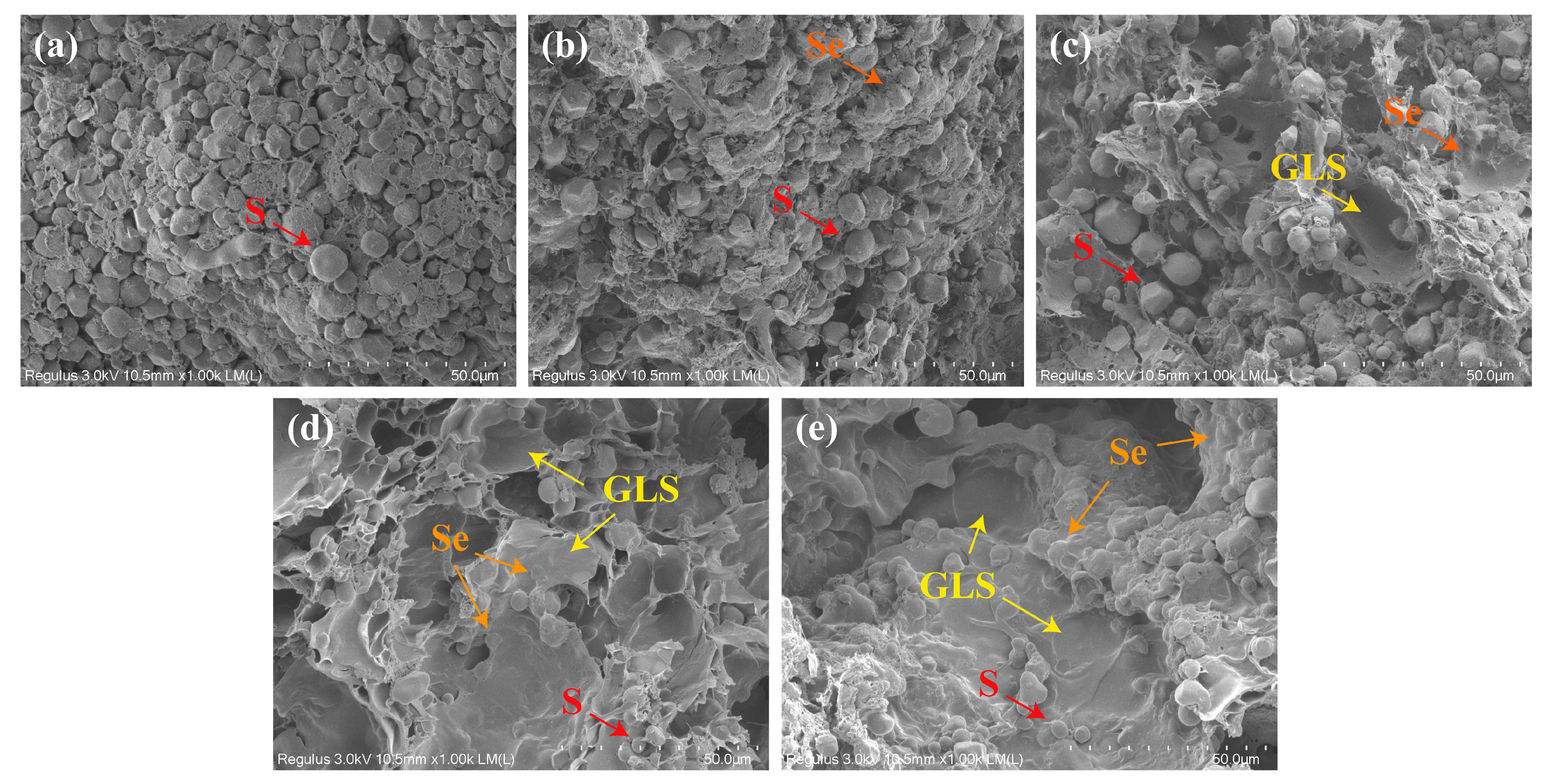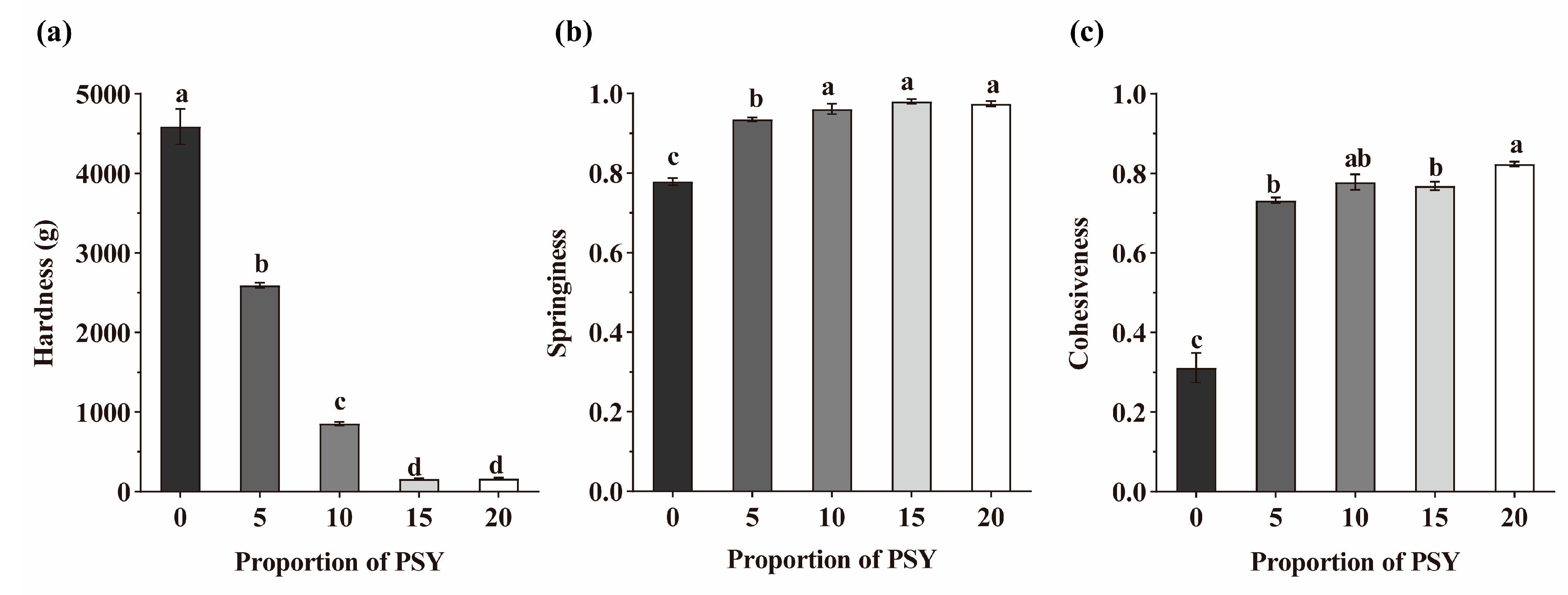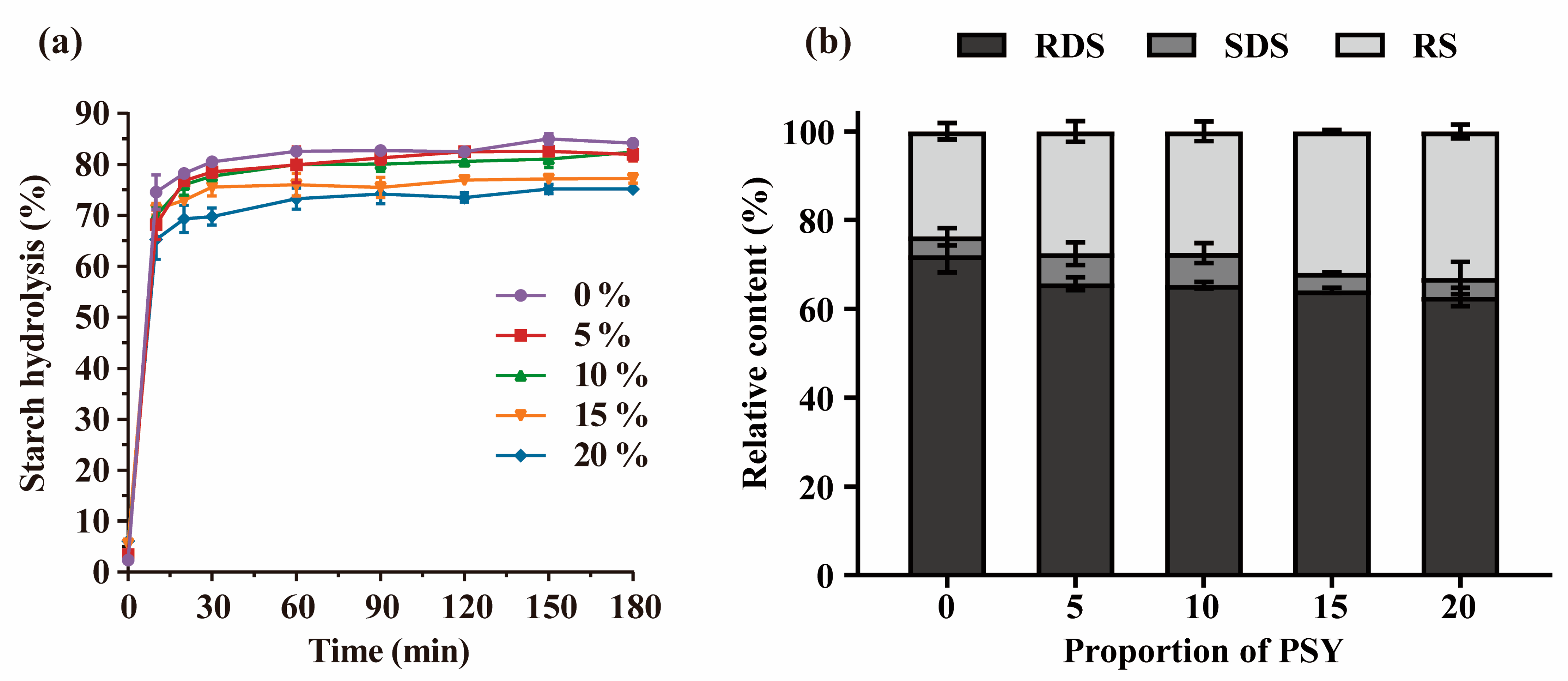Psyllium Fibre Inclusion in Gluten-Free Buckwheat Dough Improves Dough Structure and Lowers Glycaemic Index of the Resulting Bread
Abstract
1. Introduction
2. Materials and Methods
2.1. Materials and Chemical Reagents
2.2. Preparation of Dough
2.3. Analysis of the Rheological Properties of Dough
2.4. Analysis of Rheo-Fermentation Properties of Dough
2.5. Scanning Electron Microscopy
2.6. Preparation of Bread
2.7. Determination of the Specific Volume and Baking Loss of Bread
2.8. Colour Measurement of Bread
2.9. Textural Properties of Bread Crumbs
2.10. In Vitro Analysis of the Starch Digestibility of Bread
2.11. Rheological Measurements of Bread Digesta
2.12. Statistical Analysis
3. Results and Discussion
3.1. Rheological Properties of Dough
3.2. Rheo-Fermentation Properties of Dough
3.3. Microscopic Analysis of Dough Properties
3.4. Analysis of Specific Volume and Baking Loss of Bread
3.5. The Physical Appearance of Bread
3.6. Textural and Structural Properties of Bread
3.7. In Vitro Analyses of Starch Digestibility
4. Conclusions
Author Contributions
Funding
Institutional Review Board Statement
Informed Consent Statement
Data Availability Statement
Conflicts of Interest
References
- Aguiar, E.V.; Santos, F.G.; Krupa-Kozak, U.; Capriles, V.D. Nutritional facts regarding commercially available gluten-free bread worldwide: Recent advances and future challenges. Crit. Rev. Food Sci. 2021, 63, 693–705. [Google Scholar] [CrossRef]
- Grand View Research. 2023. Available online: https://www.grandviewresearch.com/press-release/global-gluten-free-products-market (accessed on 17 October 2023).
- Zhao, F.; Li, Y.; Li, C.; Ban, X.; Gu, Z.; Li, Z. Glycosyltransferases improve breadmaking quality by altering multiscale structure in gluten-free bread. Food Hydrocolloid. 2022, 133, 107951. [Google Scholar] [CrossRef]
- Santos, F.G.; Aguiar, E.V.; Capriles, V.D. Analysis of ingredient and nutritional labeling of commercially available gluten-free bread in Brazil. Int. J. Food Sci. Nutr. 2019, 70, 562–569. [Google Scholar] [CrossRef]
- Gkountenoudi-Eskitzi, I.; Kotsiou, K.; Irakli, M.N.; Lazaridis, A.; Biliaderis, C.G.; Lazaridou, A. In vitro and in vivo glycemic responses and antioxidant potency of acorn and chickpea fortified gluten-free breads. Food Res. Int. 2023, 166, 112579. [Google Scholar] [CrossRef]
- Gallagher, E.; Gormley, T.R.; Arendt, E.K. Recent advances in the formulation of gluten-free cereal-based products. Trends Food Sci. Tech. 2004, 15, 143–152. [Google Scholar] [CrossRef]
- Kaur, S.; Kumar, K.; Singh, L.; Sharanagat, V.S.; Nema, P.K.; Mishra, V.; Bhushan, B. Gluten-free grains: Importance, processing and its effect on quality of gluten-free products. Crit. Rev. Food Sci. 2022, 64, 1988–2015. [Google Scholar] [CrossRef]
- Cappa, C.; Lucisano, M.; Mariotti, M. Influence of psyllium, sugar beet fibre and water on gluten-free dough properties and bread quality. Carbohyd. Polym. 2013, 98, 1657–1666. [Google Scholar] [CrossRef] [PubMed]
- Smith, B.M.; Bean, S.R.; Herald, T.J.; Aramouni, F. Effect of HPMC on the quality of wheat-free bread made from Carob Germ Flour-Starch Mixtures. J. Food Sci. 2012, 77, C684–C689. [Google Scholar] [CrossRef] [PubMed]
- Sun, Z.-B.; Zhang, X.; Yan, Y.; Xu, J.-L.; Lu, X.; Ren, Q. The effect of buckwheat resistant starch on intestinal physiological Function. Foods 2023, 12, 2069. [Google Scholar] [CrossRef] [PubMed]
- Zhou, Y.; Zhao, S.; Jiang, Y.; Wei, Y.; Zhou, X. Regulatory function of buckwheat-resistant starch supplementation on lipid profile and gut microbiota in mice fed with a high-fat diet. J. Food Sci. 2019, 84, 2674–2681. [Google Scholar] [CrossRef] [PubMed]
- Khairuddin, M.; Lasekan, O. Gluten-free cereal products and beverages: A review of their health benefits in the last five years. Foods 2021, 10, 2523. [Google Scholar] [CrossRef] [PubMed]
- Mir, S.A.; Shah, M.A.; Naik, H.R.; Zargar, I.A. Influence of hydrocolloids on dough handling and technological properties of gluten-free breads. Trends Food Sci. Technol. 2016, 51, 49–57. [Google Scholar] [CrossRef]
- Arslan, M.; Rakha, A.; Xiaobo, Z.; Mahmood, M.A. Complimenting gluten free bakery products with dietary fiber: Opportunities and constraints. Trends Food Sci. Technol. 2019, 83, 194–202. [Google Scholar] [CrossRef]
- Sang, J.; Wen, J.; Li, L.; Xu, Y.; Gu, Q.; Yu, Y.; Peng, J. Effects of pomelo peel sponge layer insoluble dietary fibre addition on the properties of the dough and bread. Int. J. Food Sci. Tech. 2023, 58, 2344–2354. [Google Scholar] [CrossRef]
- Ziobro, R.; Korus, J.; Juszczak, L.; Witczak, T. Influence of inulin on physical characteristics and staling rate of gluten-free bread. J. Food Eng. 2013, 116, 21–27. [Google Scholar] [CrossRef]
- Culetu, A.; Duta, D.E.; Papageorgiou, M.; Varzakas, T. The role of hydrocolloids in gluten-free bread and pasta; rheology, characteristics, staling and glycemic Index. Foods 2021, 10, 3121. [Google Scholar] [CrossRef]
- Sciarini, L.S.; Bustos, M.C.; Vignola, M.B.; Paesani, C.; Salinas, C.N.; Pérez, G.T. A study on fibre addition to gluten free bread: Its effects on bread quality and in vitro digestibility. J. Food Sci. Technol. 2017, 54, 244–252. [Google Scholar] [CrossRef]
- Ronda, F.; Perez-Quirce, S.; Lazaridou, A.; Biliaderis, C.G. Effect of barley and oat β-glucan concentrates on gluten-free rice-based doughs and bread characteristics. Food Hydrocoll. 2015, 48, 197–207. [Google Scholar] [CrossRef]
- Chockchaisawasdee, S.; Mendoza, M.C.; Beecroft, C.A.; Kerr, A.C.; Stathopoulos, C.E.; Fiore, A. Development of a gluten free bread enriched with faba bean husk as a fibre supplement. LWT Food Sci. Technol. 2023, 173, 114362. [Google Scholar] [CrossRef]
- Gholami, Z.; Paknahad, Z. Effect of psyllium consumption on metabolic syndrome indices: Systematic review and dose–response meta-analysis of randomized controlled trials. J. Funct. Foods 2023, 107, 105685. [Google Scholar] [CrossRef]
- Franco, E.A.N.; Sanches-Silva, A.; Ribeiro-Santos, R.; de Melo, N.R. Psyllium (Plantago ovata Forsk): From evidence of health benefits to its food application. Trends Food Sci. Technol. 2020, 96, 166–175. [Google Scholar] [CrossRef]
- Bilgic, H.; Sensoy, I. Effect of psyllium and cellulose fiber addition on the structure and the starch digestibility of bread and crackers. Food Struct. 2023, 35, 100302. [Google Scholar] [CrossRef]
- Filipčev, B.; Pojić, M.; Šimurina, O.; Mišan, A.; Mandić, A. Psyllium as an improver in gluten-free breads: Effect on volume, crumb texture, moisture binding and staling kinetics. LWT Food Sci. Technol. 2021, 151, 112156. [Google Scholar] [CrossRef]
- Zhao, F.; Li, Y.; Li, C.; Ban, X.; Cheng, L.; Hong, Y.; Gu, Z.; Li, Z. Insight into the regulations of rice protein on the gluten-free bread matrix properties. Food Hydrocoll. 2022, 131, 107796. [Google Scholar] [CrossRef]
- Wang, X.; Lao, X.; Bao, Y.; Guan, X.; Li, C. Effect of whole quinoa flour substitution on the texture and in vitro starch digestibility of wheat bread. Food Hydrocoll. 2021, 119, 106840. [Google Scholar] [CrossRef]
- Minekus, M.; Alminger, M.; Alvito, P.; Ballance, S.; Bohn, T.; Bourlieu, C.; Carrière, F.; Boutrou, R.; Corredig, M.; Dupont, D.; et al. A standardised static in vitro digestion method suitable for food—An international consensus. Food Funct. 2014, 5, 1113–1124. [Google Scholar] [CrossRef]
- Zhu, X.-J.; Guo, X.-N.; Zhu, K.-X. Effect of sorbitol on the in vitro starch digestibility in semi-dried black highland barley noodles. Int. J. Biol. Macromol. 2023, 236, 123959. [Google Scholar] [CrossRef]
- Goni, I.; Garciaalonso, A.; Sauracalixto, F. A starch hydrolysis procedure to estimate glycemic index. Nutr. Res. 1997, 17, 427–437. [Google Scholar] [CrossRef]
- Jin, Y.; Wilde, P.J.; Li, C.; Jin, W.; Han, J.; Liu, W. Impact of food viscosity on in vitro gastric emptying using dynamic and semi-dynamic models. Food Hydrocoll. 2023, 137, 108410. [Google Scholar] [CrossRef]
- Kotsiou, K.; Sacharidis, D.-D.; Matsakidou, A.; Biliaderis, C.G.; Lazaridou, A. Physicochemical and functional aspects of composite wheat-roasted chickpea flours in relation to dough rheology, bread quality and staling phenomena. Food Hydrocoll. 2022, 124, 107322. [Google Scholar] [CrossRef]
- Yazar, G.; Demirkesen, I. Linear and non-linear rheological properties of gluten-free dough systems probed by fundamental methods. Food Eng. Rev. 2022, 15, 56–85. [Google Scholar] [CrossRef]
- Zhao, F.; Li, Y.; Li, C.; Ban, X.; Cheng, L.; Hong, Y.; Gu, Z.; Li, Z. Co-supported hydrocolloids improve the structure and texture quality of gluten-free bread. LWT Food Sci. Technol. 2021, 152, 112248. [Google Scholar] [CrossRef]
- Martínez, M.M.; Díaz, Á.; Gómez, M. Effect of different microstructural features of soluble and insoluble fibres on gluten-free dough rheology and bread-making. J. Food Eng. 2014, 142, 49–56. [Google Scholar] [CrossRef]
- Brites, L.T.G.F.; Rebellato, A.P.; Meinhart, A.D.; Godoy, H.T.; Steel, C.J. Antioxidant-enriched gluten-free bread made with buckwheat flour: Evaluation of technological and nutritional quality. Cereal Chem. 2022, 5, 995–1006. [Google Scholar] [CrossRef]
- Wang, X.; Liang, Y.; Wang, Q.; Zhang, X.; Wang, J. Effect of low-sodium salt on the physicochemical and rheological properties of wheat flour doughs and their respective gluten. J. Cereal Sci. 2021, 102, 103371. [Google Scholar] [CrossRef]
- Ziobro, R.; Witczak, T.; Juszczak, L.; Korus, J. Supplementation of gluten-free bread with non-gluten proteins. Effect on dough rheological properties and bread characteristic. Food Hydrocoll. 2013, 32, 213–220. [Google Scholar] [CrossRef]
- Mariotti, M.; Pagani, M.A.; Lucisano, M. The role of buckwheat and HPMC on the breadmaking properties of some commercial gluten-free bread mixtures. Food Hydrocoll. 2013, 30, 393–400. [Google Scholar] [CrossRef]
- Liu, X.; Mu, T.; Sun, H.; Zhang, M.; Chen, J.; Fauconnier, M.L. Influence of different hydrocolloids on dough thermo-mechanical properties and in vitro starch digestibility of gluten-free steamed bread based on potato flour. Food Chem. 2018, 239, 1064–1074. [Google Scholar] [CrossRef]
- Tabibloghmany, F.S.; Tehrani, M.M.; Koocheki, A. Effects of substitution level and particle size of extruded soybean hull fractions on physicochemical and sensorial properties of high-fiber pan bread during storage. Food Sci. Nutr. 2022, 10, 4345–4359. [Google Scholar] [CrossRef]
- Azeem, M.; Mu, T.-H.; Zhang, M. Effects of hydrocolloids and proteins on dough rheology and in vitro starch digestibility of sweet potato-wheat bread. LWT Food Sci. Technol. 2021, 142, 110970. [Google Scholar] [CrossRef]
- Ren, Y.; Linter, B.R.; Linforth, R.; Foster, T.J. A comprehensive investigation of gluten free bread dough rheology, proving and baking performance and bread qualities by response surface design and principal component analysis. Food Funct. 2020, 11, 5333–5345. [Google Scholar] [CrossRef]
- Matos, M.E.; Rosell, C.M. Relationship between instrumental parameters and sensory characteristics in gluten-free breads. Eur. Food Res. Technol. 2012, 235, 107–117. [Google Scholar] [CrossRef]
- Zeng, F.; Weng, Y.; Yang, Y.; Liu, Q.; Yang, J.; Jiao, A.; Jin, Z. Effects of wheat gluten addition on dough structure, bread quality and starch digestibility of whole wheat bread. Int. J. Food Sci. Tech. 2023, 58, 3522–3537. [Google Scholar] [CrossRef]
- Zhang, H.; Li, Z.; Zhang, L.; Lai, P.F.; Tian, Y.; Cui, S.W.; Ai, L. Effects of soluble dietary fibers on the viscosity property and digestion kinetics of corn starch digesta. Food Chem. 2021, 338, 127825. [Google Scholar] [CrossRef]
- Ge, F.; Wu, P.; Chen, X.D. Evolutions of rheology, microstructure and starch hydrolysis of pumpkin-enriched bread during simulated gastrointestinal digestion. Int. J. Food Sci. Technol. 2021, 56, 6000–6010. [Google Scholar] [CrossRef]
- Englyst, H.N.; Kingman, S.M.; Cummings, J.H. Classification and measurement of nutritionally important starch fractions. Eur. J. Clin. Nutr. 1992, 46, S33–S50. [Google Scholar] [PubMed]
- Van Hung, P.; Chau, H.T.; Phi, N.T.L. In vitro digestibility and in vivo glucose response of native and physically modified rice starches varying amylose contents. Food Chem. 2016, 191, 74–80. [Google Scholar] [CrossRef]
- Freitas, D.; Souchon, I.; Le Feunteun, S. The contribution of gastric digestion of starch to the glycaemic index of breads with different composition or structure. Food Funct. 2022, 13, 1718–1724. [Google Scholar] [CrossRef] [PubMed]








| PSY Proportion | Crust | Crumb | ||||
|---|---|---|---|---|---|---|
| L* | a* | b* | L* | a* | b* | |
| 0% | 67.81 ± 0.92 a | 0.24 ± 0.03 d | 15.34 ± 0.37 c | 46.70 ± 0.95 c | 1.13 ± 0.10 d | 8.79 ± 0.16 b |
| 5% | 58.03 ± 0.50 b | 3.12 ± 0.05 c | 15.40 ± 0.03 c | 47.78 ± 0.93 c | 1.72 ± 0.15 c | 9.22 ± 0.15 b |
| 10% | 49.86 ± 0.93 c | 5.21 ± 0.04 b | 17.52 ± 0.20 a | 51.40 ± 0.68 b | 2.32 ± 0.13 b | 9.77 ± 0.38 ab |
| 15% | 46.55 ± 0.17 d | 5.64 ± 0.26 a | 17.13 ± 0.31 ab | 54.33 ± 0.58 a | 2.51 ± 0.05 b | 9.78 ± 0.18 ab |
| 20% | 45.83 ± 0.23 d | 5.92 ± 0.10 a | 16.77 ± 0.16 b | 53.95 ± 0.34 a | 2.95 ± 0.09 a | 9.99 ± 0.24 a |
| PSY Proportion | C∞ (%) | k (min−1) | R2 |
|---|---|---|---|
| 0% | 82.93 | 0.1533 | 0.9981 |
| 5% | 82.11 | 0.1391 | 0.9942 |
| 10% | 80.26 | 0.1982 | 0.9802 |
| 15% | 76.45 | 0.1973 | 0.9867 |
| 20% | 75.09 | 0.1560 | 0.9893 |
| PSY Proportion | RDS (%) | SDS (%) | RS (%) |
|---|---|---|---|
| 0% | 72.03 ± 3.80 a | 4.25 ± 1.92 a | 23.72 ± 1.88 b |
| 5% | 65.70 ± 1.42 b | 6.79 ± 2.56 a | 27.51 ± 2.33 b |
| 10% | 65.35 ± 0.71 b | 7.24 ± 2.25 a | 27.41 ± 2.20 b |
| 15% | 64.19 ± 0.61 b | 3.85 ± 0.31 a | 31.96 ± 0.32 ab |
| 20% | 62.71 ± 2.05 b | 4.25 ± 3.62 a | 33.04 ± 1.57 a |
Disclaimer/Publisher’s Note: The statements, opinions and data contained in all publications are solely those of the individual author(s) and contributor(s) and not of MDPI and/or the editor(s). MDPI and/or the editor(s) disclaim responsibility for any injury to people or property resulting from any ideas, methods, instructions or products referred to in the content. |
© 2024 by the authors. Licensee MDPI, Basel, Switzerland. This article is an open access article distributed under the terms and conditions of the Creative Commons Attribution (CC BY) license (https://creativecommons.org/licenses/by/4.0/).
Share and Cite
Gao, Z.; Wang, G.; Zhang, J.; Guo, L.; Zhao, W. Psyllium Fibre Inclusion in Gluten-Free Buckwheat Dough Improves Dough Structure and Lowers Glycaemic Index of the Resulting Bread. Foods 2024, 13, 767. https://doi.org/10.3390/foods13050767
Gao Z, Wang G, Zhang J, Guo L, Zhao W. Psyllium Fibre Inclusion in Gluten-Free Buckwheat Dough Improves Dough Structure and Lowers Glycaemic Index of the Resulting Bread. Foods. 2024; 13(5):767. https://doi.org/10.3390/foods13050767
Chicago/Turabian StyleGao, Zihan, Guangzhen Wang, Jing Zhang, Lichun Guo, and Wei Zhao. 2024. "Psyllium Fibre Inclusion in Gluten-Free Buckwheat Dough Improves Dough Structure and Lowers Glycaemic Index of the Resulting Bread" Foods 13, no. 5: 767. https://doi.org/10.3390/foods13050767
APA StyleGao, Z., Wang, G., Zhang, J., Guo, L., & Zhao, W. (2024). Psyllium Fibre Inclusion in Gluten-Free Buckwheat Dough Improves Dough Structure and Lowers Glycaemic Index of the Resulting Bread. Foods, 13(5), 767. https://doi.org/10.3390/foods13050767






